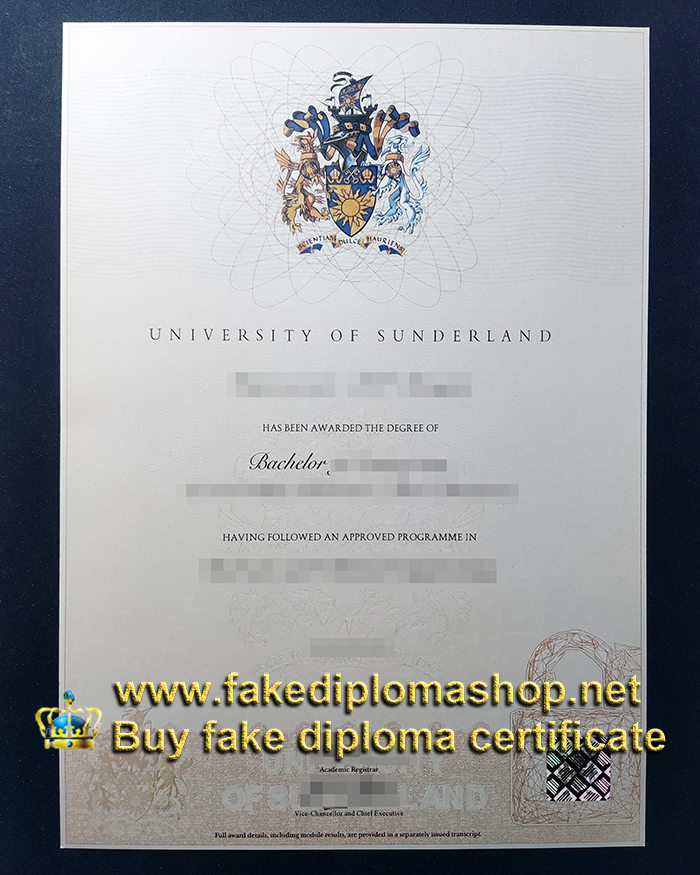
New version University of Sunderland diploma
How to duplicate New version University of Sunderland diploma now? Where to spot a fake diploma shop to buy a fake University of Sunderland diploma and transcript? How much to buy a fake University of Sunderland degree certificate? Can I buy a fake diploma to replace my Lost University of Sunderland diploma? Purchase a fake University of Sunderland diploma online, fake University of Sunderland diploma for sale, best diploma for sale, buy fake diploma and transcript in the UK. The University of Sunderland is a public research university located in Sunderland in the North East of England.
Founded in 1901, the University of Sunderland (University of Sunderland) is a British public comprehensive research University located in the northeastern coastal region of England. It is adjacent to the University of Newcastle upon Tyne and Durham University, the third oldest University in England. Adjacent to the North Sea, Washington, the American president, was born here and is an important seaport city in the northeast of England.
The University of Sunderland consists of four faculties, namely The School of Art, Design and Communication, The School of Business and Law, The School of Applied Science, and The School of Education and Sociology. It has a London Campus in London and an overseas Campus in Hong Kong, China. The school has an enrollment of 17,101 students, including 2,695 international students from 118 countries and regions.
Sunderland has been an important center of education since Benedict Biscope built St Peter’s Church and Abbey in 674 AD. St. Peter’s is home to the largest office building north of the Alps. The oldest surviving Latin version of the Bible, the Codex Amiatinus, was written in St. Peter’s. The site has been developed as the Sir Tom Cowie campus of The University of Sunderland at St Peter’s. The university’s £9 million Centre for Advanced Media, opened in 2004, is located near St Peter’s Church in Monkwellmouth.
The university’s modern roots can be traced back to 1901, when the Sunderland Technical College was established as a municipal training college. It was the first to offer sandwich classes. It began with four departments: chemistry, mechanical and civil engineering, physics and electrical engineering, and Business and Languages. Part-time lecturers teach other subjects, from Latin to navigation. 671 students were enrolled in the first year; That’s more than three times the expected number.
Its longest-serving president, the physicist VA Mundella, was appointed in 1908 and served until his retirement in 1932. The Department of Pharmacy and the Department of Shipbuilding were established in 1921 and 1922 respectively. The Department of Pharmacy began as a separate bench in the Department of Chemistry, but soon grew to be the largest in the country. From 1930, a number of students in the School of Applied Science began to study for Durham university degrees. In 1930, the Department of Mining was established and pharmacy students could study for a Bachelor of Pharmacy from The University of London. Sunderland was also recognized by the University of London as its Centre for BEng (Bachelor of Engineering) degrees in 1934.
During the Second World War, Sunderland ran special courses for the Armed Forces and the Department of Labor. A PDP-8 hybrid computer was installed at the Chester Road site in the 1960s. And an Elliot Brothers 803B digital computer. The Duke of Edinburgh opened a new complex on nearby Chester Road, in 1964, including a new student union and dormitory facilities.


 Fake USA Degrees
Fake USA Degrees Fake CAD Degrees
Fake CAD Degrees Fake AUS Degrees
Fake AUS Degrees Fake UK Degrees
Fake UK Degrees Fake International Degrees
Fake International Degrees
